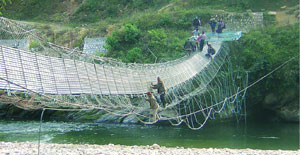|
|
The Nepali Times has reminded readers of the need to begin economic reconstruction and development in post-conflict Nepal in its editorial ('Guns and slogans', #297) urging donors to 'Unleash a Marshall Plan'.
'Unleash' in the figurative sense is used for unleashing one's temper or 'the dogs of war'. Neither this military idiom, nor the paradigm embodied in the Marshall Plan is appropriate in present day Nepal.
Meant for a different time and place the Marshall Plan worked for different reasons. It derived its name from US secretary of state George C Marshall who first suggested it with the objective of healing the wounds of the Second World War in Western Europe. Between 1948-52 the United States pumped into Western Europe about $13 billion in food, machinery and other products.
Europe did recover and began to achieve well-being with the Marshall Plan but it did not happen simply as a result of the Plan. The notion that well-being, prosperity and happiness could be enjoyed hereafter in human life by common citizens was a result of the 18th century European enlightenment. Three preconditions converged to bring it about: the rational pursuit of self interest for an individual's material betterment and progress, achievements in science and technology and the competitive market, universities as sites of knowledge production, problem solving capacity building, primacy of the rule law, representative polity, accountable governance and functioning institutions of capitalism such as banking and insurance.
Despite the physical devastation wrought by a monstrous war, the social wherewithal built over several centuries was intact. It only needed the injection of capital in the form of Marshall Plan to lead Europe to greater height of prosperity.
The situation in many developing countries including Nepal is different. In Europe the wounded organism called capitalism could be revived with the Marshall Plan. In Nepal, a new organism (an effective instrument of capitalism) has to be first created and no external plan can do that in the absence of national statesmanship and visionary leaders. Fifty years of development aid has not been able to create the required attributes. Aid money has tended create a parasitic class, and aid projects generally have been expensive, ineffective and unsustainable. The problem is not lack of resources but why money cannot be converted into productive capital.
The question is not whether we should develop infrastructure but how. Overall Nepal may not have fared well in 50 years of development, but, in creative partnership with less bureaucratised foreign support, Nepalis have made innovations in major sectors of development. Successful examples are community forestry, community-based drinking water supply and farmer-managed irrigation systems are others.
The decentralised approach to building trail suspension bridges, micro-hydropower, biogas, the national private sector's participation in hydropower development and community distribution of electricity. The strength of these innovations is institutional rooted-ness, which can yield rich dividends with well-targeted support. The tragedy of Nepal after 1950 has been that those bestowed with leadership responsibilities have tended to disregard such innovations and instead sought grandiose ideas and solutions from outside.
Nepal's challenges are democratising the mechanism for creation of new assets and converting them into a productive capital. If one recognises this as a basic tenet, then the character of how transformation would occur becomes a function of the nature of local societies, education, institutional base, politics, and the physical landscape. Physical models of development from elsewhere cannot be transplanted without major modifications in our unique environment.
The march of capitalism has shown how the transformation took place in the West. Western societies were also able to put in place institutional innovations to soften the impact of rapacious capitalism by developing competent governments, competitive markets and by fostering tolerance and understanding of their dissenting civic movements much better than the developing countries.
The way forward for Nepal is to decentralise competent government, competitive market and a critical and dissenting civic movement to its mofsul and fostering creative interaction among them. This creative interaction can fare better when individual initiatives can flourish, when government regulation are facilitative and not restrictive, and when alert civil society champions broader ethical values. Nepal should rejoice in many plans of local make and not be straitjacketed into a 'Marshall Plan'.
Ajaya Dixit is a water resource analyst with Nepal Water Conservation Foundation.




